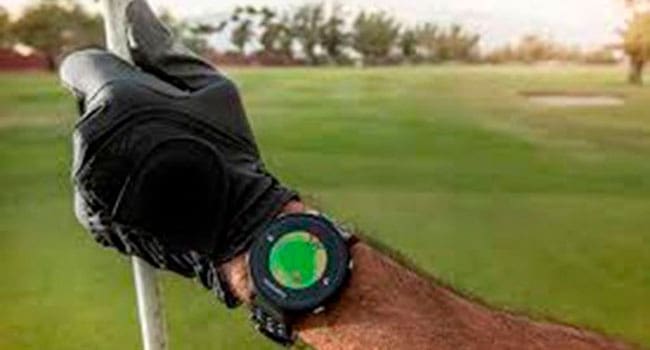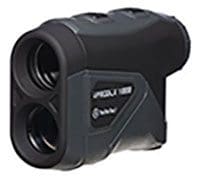 There’s a story – probably apocryphal – about the notoriously fastidious German golfer Bernhard Langer. According to the legend, Langer asked his caddy for a distance on a shot he was about to make.
There’s a story – probably apocryphal – about the notoriously fastidious German golfer Bernhard Langer. According to the legend, Langer asked his caddy for a distance on a shot he was about to make.
“It’s 145 yards from the sprinkler head,” replied the caddy.
“Is that 145 yards from the front of the sprinkler head or 145 yards from the back of the sprinkler head?” Langer was alleged to have replied.
Okay, some golfers are very, very precise about measuring the distances their shots must travel. On the PGA and LPGA Tours, this precision is the currency of the realm. For the average player, an approximation of the distance within five or 10 yards is often enough.
Either way, rangefinders have become a familiar sight on courses and ranges where players work on their craft. Now, they’re legal to use in all but the top levels of the PGA and LPGA – and even that’s changing.
Once, the golf industry thought GPS units in carts was the future of rangefinders. Then I went to the annual golf merchandise show in January in Orlando, Fla. The section of the massive show devoted to GPS devices was minuscule. Knowing how much players want precision for their shots, I asked why so few displays?
The rep pointed to his wrist. “Portable. That’s the future of the golf rangefinder,” he said glumly. “Portable technology has taken over.”
By portable he meant hand-held laser units and wrist watches that give distances to the golfer. But which product would triumph in the marketplace? Turns out both technologies have their supporters.
I decided to test both technologies for a few weeks to see which I preferred. There are many reputable hand-held laser units out there, but for my purposes I used the TecTecTec VPRO DLX 1K high-performance unit. Like other hand-held units, it can seek a sensor target on the flag stick or trees, mounds and water hazards.
According to the maker, the unit is accurate to within a yard from 1,000 yards away. It has “three scanning modes – Pinsensor measures overlapping targets, including flagsticks and wooded areas; Target Priority displays distance of the closest subject; and Scan Mode helps read distances to hazards.” It’s also remarkably light. As opposed to other handhelds I saw, the VPRO DLX 1K features a vertical, not horizontal shape – which I preferred. It’s also very light at just 0.19 kg.
The pictures and measurements delivered were crisp and accurate. Its long-distance readings were also very helpful. For the golfer who wants precision, the unit is perfect.
My reservations about all hand-helds are user dependent.
For the golfer who walks a course, there’s the problem of steadying the unit when the heart rate is elevated or the weather conditions buffet the player. Getting my VPRO DLX 1K steady to read the distance was an effort in challenging weather or hilly ground.
The second drawback is not the fault of the manufacturer. As a loose object, the portable rangefinder is prone to getting lost – again, especially for the walker. I have found units on tee boxes and beside greens, left behind by absent-minded players.
Otherwise, the VPRO DLX 1K was accurate, portable and I recommend it to the serious golfer who wishes a very specific distance. Cost ranges from US$199 to $299.
The competition for range finders is in watches, which have become increasingly diverse. I tested the Garmin S6, the latest generation of the Garmin watch I’ve already used. From the first efforts, which simply delivered approximate measurements on up to 25,000 courses in North America, the Garmin S6 is a Swiss Army watch of golf tools.
It now allows the convenience of readings on the watch plus shot distances, detailed scoring of rounds, swing strength, tempo training and a downloadable program to track results. Golfers can also program local details about a course that were not available on early models.
One complaint in previous watches was the fixed front/middle/back measurements on greens. But the Garmin S6 has a colour greens mode that allows the golfer to move the target flag to a more accurate placement on the green. All distances from tee to green are subsequently re-calibrated in a clear screen. Distances to hazards also are now much easier to view.
Golfers can trace the distance on shots by simply activating a button on the watch. Now drives can be measured for bragging rights or putts can be stepped off for better accuracy. The swing strength and tempo trainers in the watch incorporate separate units that were once bought separately. They’re useful tools for the range or offseason.
Plus, the Garmin S6 readings are unaffected by weather conditions or steadiness of hand. Because it’s fixed to the wrist, there’s no chance of leaving it behind on the course (although sun lovers will be left with a light tan band on the arm). And the battery life has been greatly improved to allow for multiple games without recharging. The Garmin S6 can be found for as cheap as Cdn$249.
There’s something for every type of golfer between the Garmin S6 tech and the VPRO DLX 1K. With so much data at hand, all you’ll need now is Dustin Johnson to hit your shots and golf will be a beautiful thing.
Troy Media columnist Bruce Dowbiggin career includes successful stints in television, radio and print. A two-time winner of the Gemini Award as Canada’s top television sports broadcaster, he is also the publisher of Not The Public Broadcaster.
The views, opinions and positions expressed by columnists and contributors are the author’s alone. They do not inherently or expressly reflect the views, opinions and/or positions of our publication.


